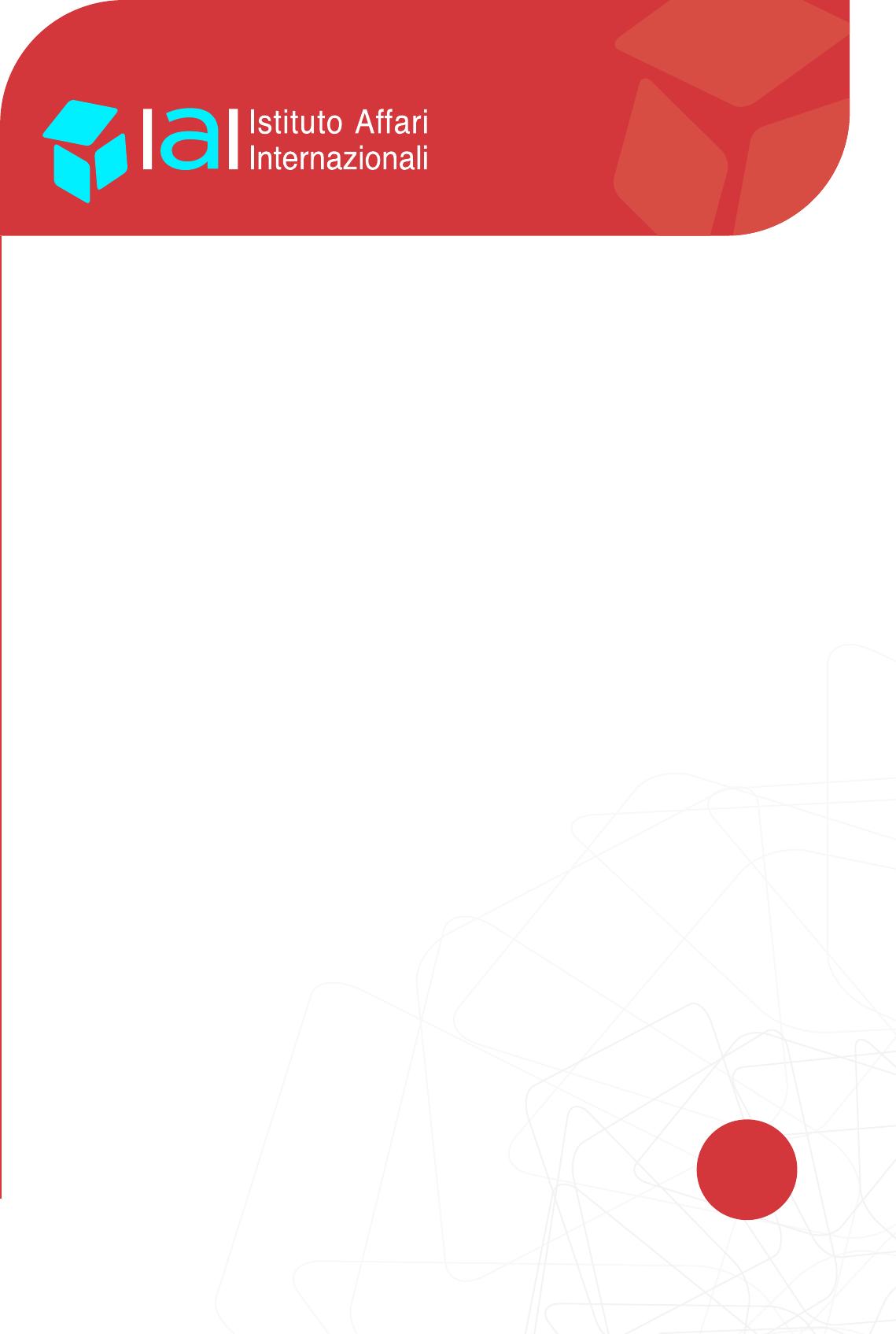©2022IAIIAIPAPERS2217-JUNE2022ISSN2610-9603ISBN978-88-9368-255-8ItalyPipelinesEnergyHydrogenExternaltradeTheGeopoliticsofCleanHydrogen–OpportunitiesandChallengesforItalybyMarcoGiulikeywordsABSTRACTTheemergenceofcleanhydrogenasanenergycarrierpromisestoshapethefuturegeographyoftheenergytrade.Undergrowingcontestationofinterdependence,suchageographyshouldbereadthroughpoliticallensesalongsidecommercialandtechnologicalones.Generally,hydrogenislikelytoreducethegeopoliticalsensitivityofenergytradewithrespecttoafossil-fuel-basedenergyorderbyincreasingtheshareofenergyproduceddomestically,shiftinggeostrategiccompetitionfromafocusongrabbingresourcestoafocusonmasteringtechnologyandsettingstandards,andofferingpetrostatesopportunitiesforeconomicdiversification.Italycanexploittheopportunitiesofferedbyahydrogeneconomyforenhancingitsenergysecurityandpositioningintheregionalenergytrade.However,itshouldbecarefulwithmonitoringhowgeopoliticalbarrierssuchasregionalinstabilitymayaffectitshydrogenambitions.2TheGeopoliticsofCleanHydrogen–OpportunitiesandChallengesforItaly©2022IAIIAIPAPERS2217-JUNE2022ISSN2610-9603ISBN978-88-9368-255-8TheGeopoliticsofCleanHydrogen–OpportunitiesandChallengesforItalybyMarcoGiuliIntroductionTheenergytransitionisexpectedtobringaboutastructuralchangeinmanysocio-technicalfoundationsofourcivilisation,1includingthewayinwhichpowerandinfluenceareallocatedandexertedontheinternationalstage.Itisexpectedtoreducethoseinterdependenciesbornaroundfossilfueltrade,andtogiverisetoemerginginterdependencieswheretechnology,infrastructureandregulationcountmorethangeologicalendowments.2Similarly,aselectrificationgrowsandsinceelectricityisnotanefficientcarrieroverlongdistances,theenergytransitionisexpectedtodefineaworldthatislessglobal–atleastwithintheenergyissuearea–andmoreregional,orevennational,3layingthegroundworkformajorgeopoliticalshifts.Theentryofcleanhydrogenintotheglobalenergytransitionequationmayatleasttosomeextentchallengetheseassumptions.Cleanhydrogenincludeshydrogenproducedviaelectrolysisfromnon-emissiveelectricityfromrenewables(greenhydrogen)ornuclear(pinkhydrogen),andhydrogenproducedthrough1GavinBridgeetal.,“GeographiesofEnergyTransition:Space,PlaceandtheLow-CarbonEconomy”,inEnergyPolicy,Vol.53(February2013),p.331-340,https://doi.org/10.1016/j.enpol.2012.10.066.2TomCasier,“TheGeopoliticsoftheEU’sDecarbonizationStrategy:ABird’sEyePerspective”,inClaireDupontandSebastianOberthür(eds),DecarbonizationintheEuropeanUnion.InternalPoliciesandExternalStrategies,Basingstoke/NewYork,PalgraveMacmillan,2015,p.159-179.3DanielScholtenetal.,“TheGeopoliticsofRenewables:NewBoard,NewGame”,inEnergyPolicy,Vol.138(March2020),Article111059.MarcoGiuliisScientificAdvisorattheIstitutoAffariInternazionali(IAI),wherehecontributestotheProgramme“Energy,ClimateandResources”.HeisaResearcherattheInstituteforEuropeanStudiesoftheFreeUniversityofBrussels(VUB)andanAssociatePolicyAnalystattheEuropeanPolicyCentre(EPC)..Paperpreparedinthecontextoftheproject“TheroleofItalyintheinternationaleconomyofhydrogen:geo-economicandgeopoliticalimplications”,aprojectrunbytheIstitutoAffariInternazionali(IAI)withthesupportoftheItalianMinistryofForeignAffairsandInternationalCooperation(MAECI)andCompagniadiSanPaoloFoundation.Viewsexpressedaretheauthor’salone.3TheGeopoliticsofCleanHydrogen–OpportunitiesandChallengesforItaly©2022IAIIAIPAPERS2217-JUNE2022ISSN2610-9603ISBN978-88-9368-255-8methanereformingwiththeadditionofcarboncaptureandstorage(bluehydrogen)Byofferingthepossibilityofturningelectronsintomoleculesandthenbacktoelectrons,hydrogenpromisestobecomeacarrierforcleanenergyoverlongdistances,potentiallyreproducinginfrastructuralandgeographicalinterdependenciesthatweretypicalofthefossil-fuel-basedorder,dependingonitsgenerationroute.Theexportofgreenhydrogen–generatedviaelectrolysis–mightgiverisetoemergingelectrostates.Theexportofbluehydrogen–producedfrommethanereformingprocesseswiththeadditionofcarboncaptureandstorage(CCS)–couldallowgasexporterstopreservesomeroleinthenewenergymap.However,atacloserinspection,hydrogen’sdistinctivetechnologicalfeaturesmayalsocallintoquestionthepossibilityforsuchacarriertobecomea“newoil”inthebroaderglobalpoliticalpicture.Hydrogen’sgeopoliticaldimensionwillbelargelydefinedbywhatchoicesstatesandcommercialactorswilltakewithrespectto:producingitdomesticallyorimportingit;producingitforexport,orusingitdomesticallyandattractingfinalusersfromabroad;privilegingitsuseinessentialhard-to-abatesectorssuchasthesteel,chemicalorrefiningindustries,orasasubstituteforelectrificationinresidentialheatingorroadtransport.4Inturn,thebroadergeopoliticalenvironmentisalsoexpectedtoplayaroleinorientingactorstomaketheirchoices.Thesequestionsobligeustothinkabouthydrogenindistinctivegeopoliticalterms.Thispaperexaminesthepotentialgeopoliticsofhydrogen,lookingfirstatwhattypeofgeographytheemergenceofhydrogentechnologiesislikelytoproduce,thenexploringthepotentialelementsofgeopoliticalcontestationsassociatedwithhydrogeninterdependencies,andfinallyreflectingongeopoliticalopportunitiesandbarriersthatItalycouldmeetasitseekstobecomeaninternationalhydrogenactor.ThisworkcomplementsapreviouspaperthatinquiredaboutItaly’sprospectivecollocationinanemerginginternationaleconomyofcleanhydrogen.51.DefiningcleanhydrogengeographyAtpresent,hydrogenisnotaninternationallytradedcommodity.Hydrogenisproducednationallybyitsconsumersmostlyfromnaturalgas,whilecross-bordertradeinfrastructuresarelargelynon-existent.Whileproductionandconsumptionofcleanhydrogenarelikelytomaintainanationaldimensionintheshortterm,elementsofregionalismorevenglobaltrademayemergeoverthelongterm,reflectingtheevolutionofmaterialconditionssuchasproductioncostdifferentialsanddynamicsintransportationcost,andthewillofactorstoengage4ThijsVandeGraafetal.,“TheNewOil?TheGeopoliticsandInternationalGovernanceofHydrogen”,inEnergyResearch&SocialScience,Vol.70(December2020),Article101667,https://doi.org/10.1016/j.erss.2020.101667.5MarcoGiuli,ItalyintheInternationalHydrogenEconomy,Rome,IAI,February2022,https://www.iai.it/en/node/14708.4TheGeopoliticsofCleanHydrogen–OpportunitiesandChallengesforItaly©2022IAIIAIPAPERS2217-JUNE2022ISSN2610-9603ISBN978-88-9368-255-8ininternationalhydrogenrelations.However,asthegeopoliticsoffossilfuelscannotprescindfromtheirpervasivenessintheglobaleconomy,understandingthegeopoliticalimplicationsofahydrogeneconomywouldrequirefirsttomakeassumptionsaboutthesizeofhydrogentrade.1.1AssumingthesizeofcleanhydrogentradeConsideringtheuncertaintieswithrespecttopolicy,technologyandconsumerpreferences,scenariosaboutthefuturedemandforhydrogenshowremarkabledivergences.AccordingtoBloombergNEF,hydrogenmayaccountbetween4and24percentofglobalfinalenergyconsumptionby2050.6AccordingtotheIEAnetzeroscenario,hydrogenconsumptionwouldrisefrom87milliontonnesofhydrogen(MtH2)in2020to528MtH2in2050,68percentofwhichwouldbeproducedviaelectrolysisand38percentviafossilfuels.7AccordingtoascenarioelaboratedbytheHydrogenCouncil,in2050hydrogenwillaccountfor18percentoffinalenergyconsumption,correspondingto641MtH2.Onthebasisoftheseestimates,onecouldconsideraglobalproductionofabout600MtH2/yrby2050(72exajoulesofenergy)asareasonablecentralestimatefromthemostoptimisticscenarios.Assumingthattheinternationaltradeofhydrogenandhydrogenproductswouldamountto25percentofglobalproduction–basedonthecurrentproportionofinternationallytradednaturalgaswithrespecttototalnaturalgasproduction–theinternationallytradedvolumeofhydrogenwouldcorrespondtoabout18exajoules(EJ).Thisamountstoafractionoftradedvolumesoffossilfuelsin2019,totalling217.72EJ.Atthesametime,itisnotanegligibleamountifcomparedtocurrentlytradedvolumesofnaturalgas,amountingto37.2EJin2019.1.2GeographyofcostsandcomparativeadvantagesSeveralconditionscanbeidentifiedfortheemergenceofinternationalhydrogenvaluechains:theexistenceofcomparativeadvantagesbetweendifferenteconomies,structuringtheincentivesfortheemergenceofinterstatetradeofbothhydrogen-relatedproductsandassociatedtechnologies;andthepoliticalwill,atanationallevel,toidentifyopportunitiesforimportingorexportinghydrogenandhydrogen-relatedproductsandtechnologies,adaptingnationalindustrialpoliciesandinternationalpartnershipsaccordingly.86BloombergNEF,HydrogenEconomyOutlook.KeyMessages,30March2020.https://data.bloomberglp.com/professional/sites/24/BNEF-Hydrogen-Economy-Outlook-Key-Messages-30-Mar-2020.pdf.7Whichmodelledhydrogendemandinordertofillgapswhereelectricitycannoteconomicallyreplacefossilfuelsandwherelimitedsustainablebioenergysuppliescannotcopewithdemand.InternationalEnergyAgency(IEA),NetZeroby2050.ARoadmapfortheEnergySector,Revisedversion(4threvision),October2021,https://www.iea.org/reports/net-zero-by-2050.8ThijsVandeGraafetal.,“TheNewOil?”,cit.5TheGeopoliticsofCleanHydrogen–OpportunitiesandChallengesforItaly©2022IAIIAIPAPERS2217-JUNE2022ISSN2610-9603ISBN978-88-9368-255-8Figure1Costofhydrogensupplybylocation(USdollars/kgH2)Source:Author’selaborationonIEA2020data.Thedeterminantsofcomparativeadvantageinthehydrogentradeincludealow-costavailabilityofrenewableenergysources(RES)and/orpotentialandfreshwateravailabilityasforgreenhydrogen;andlow-costnaturalgasavailabilityandCCSpotentialasforbluehydrogen.9Existinggasinterconnectionsidentifymarketaccesspotentialforfuturehydrogenproducers,whiledemandcentresareexpectedtodevelopinlargeclustersofemission-intensiveindustries.TheIEAforeseesthatthelong-termcostofimportedhydrogenislikelytobeunattractivefortheUnitedStateswithrespecttothedomesticproductionofbothblueandgreenhydrogen,whilealargerrationaleforcleanhydrogenimportsispresentinEuropeandJapan(seeFigure1).Ontheotherhand,low-costproducersareexpectedtoemergeinAustralia,theMiddleEastandNorthAfrica,andChile.Takingintoaccounttransportcosts,costdifferentialscreateidealsynergiesbetweenNorthAfricaandNorwayasexportersandEuropeasanimporterviapipelinetrade;andbetweenAustraliaandEastAsiaviaships.Ontheotherhand,countrieslikeChileortheGulfstateswouldbeinapositionofplayingarbitragebetweendifferentregionalmarkets–withanoption,forChile,alsotoservetheLatinAmericanmarketifitweretodevelop.109FridolinPflugmannandNicolaDeBlasio,“GeopoliticalandMarketImplicationsofRenewableHydrogen”,inBelferCenterReports,March2020,https://www.belfercenter.org/node/128441.10Pipelinetradeofpurehydrogeningaseousformismoreconvenientthanshippinghydrogenviaammoniaforupto3,000km(USdollars1.3/kgH2),vialiquidorganichydrogencarriers(LOHC)for6TheGeopoliticsofCleanHydrogen–OpportunitiesandChallengesforItaly©2022IAIIAIPAPERS2217-JUNE2022ISSN2610-9603ISBN978-88-9368-255-8Suchageographywouldtoanotableextentreproducethecurrentgeographicaltrajectoriesofgastrade.1.3PoliticalwillAsecondelementtoconsiderwhenlookingatthefuturegeographyofhydrogentradeisthepoliticalwilltodomesticallydevelophydrogendemandand/orsupplyandopeninguptotheopportunityofinternationalhydrogentrade.Nationalhydrogenstrategies,althoughoftenlackingsufficientdetail,constituteapredictorofcountries’self-perceptionofthepotentialroletheycouldplayinaninternationalhydrogeneconomy.Amongprospectiveexporters,themostambitiousstrategieshavebeenreleasedbyAustralia,11Chile,12Morocco,13Russia,14SaudiArabia,15theUnitedArabEmirates(UAE)16andOman,17whileopportunitiesforcleanhydrogenexportsarealsomentionedinthestrategiesofNewZealand,18Canada19andsuchLatinAmericancountriesasColombia,ArgentinaandBrazil.Otherstrategiesunderlinetheneedforimportingcleanhydrogenfromabroad.TheseincludetheEU,Germany,20theupto4,000km(USdollars1.6/kgH2)andinpureliquidformforupto4,600km(USdollars1.9/kgH2).IEA,TheFutureofHydrogen.SeizingToday’sOpportunities,June2019,p.78,https://www.iea.org/reports/the-future-of-hydrogen.11COAGEnergyCouncil,Australia‘sNationalHydrogenStrategy,2019,https://www.industry.gov.au/node/69001.12Chile,NationalGreenHydrogenStrategy,MinistryofEnergy,November2020,https://energia.gob.cl/sites/default/files/national_green_hydrogen_strategy_-_chile.pdf.13LucaFranza,CleanMoleculesacrosstheMediterranean.ThePotentialforNorthAfricanHydrogenImportsintoItalyandtheEU,Rome,IAI,April2021,p.13-17,https://www.iai.it/en/node/13116.14YanaZabanovaandKirstenWestphal,“RussiaintheGlobalHydrogenRace”,inSWPCommentaries,No.34(May2021),https://doi.org/10.18449/2021C34.15JanFrederikBraun,“SaudiArabia’sCleanHydrogenPlansforConvertingAmbitionsintoAction”,inEnergyPost,19March2021,https://energypost.eu/?p=32318.16WatsonFarley&Williams,“HydrogenintheUAE”,inWFWArticles,2June2021,https://www.wfw.com/articles/hydrogen-in-the-uae.17JamesBurgess,“World’sLargestRenewableHydrogenDeveloperAdds25-GWOmanExportProject”,inS&PGlobal,18May2021,https://www.spglobal.com/platts/en/market-insights/latest-news/petrochemicals/051821-worlds-largest-renewable-hydrogen-developer-adds-25-gw-oman-export-project.18NewZealand,AVisionforHydrogeninNewZealand.GreenPaper,MinistryofBusiness,Innovation&Employment,September2019,https://www.mbie.govt.nz/dmsdocument/6798.19Canada,HydrogenStrategyforCanada,MinistryforNaturalResources,December2020,https://www.nrcan.gc.ca/node/23080.20Germany,TheNationalHydrogenStrategy,FederalMinistryforEconomicAffairsandEnergy,June2020,https://www.bmwk.de/Redaktion/EN/Publikationen/Energie/the-national-hydrogen-strategy.html;BerndRadowitz,“World’sLargestHydroDamCouldSendCheapGreenHydrogenfromCongotoGermany”,inRechargeNews,8September2020,https://www.rechargenews.com/transition/2-1-871059.7TheGeopoliticsofCleanHydrogen–OpportunitiesandChallengesforItaly©2022IAIIAIPAPERS2217-JUNE2022ISSN2610-9603ISBN978-88-9368-255-8Netherlands,Japan,21andSouthKorea.22Yet,noteverystrategyisoutward-looking.TheUnitedStates,23France,24Poland,Spain,Portugal,andChina25emphasisetheprospectsofdevelopingadomesticsupplychain,seekingindustrialprimacyandsecuritygains.Table1summarisesthetargetsandtechnologicalpreferencesofthemainnationalstrategies,atthetimeofwriting.Table1NationalhydrogenstrategiesCountryElectrolysistarget(2030)Domesticusetarget(2030)ProductionrouteFinaluseCommittedpublicinvestment(bndollars)Australia--Coal+CCUSGas+CCUSRES+electrolysisBuildings,electricity,exports,industry,shipping,roadtransport0.9Canada-4MtH2/yBiomassby-productRES+electrolysisGas+CCUSOil+CCUSBuildings,electricity,exports,mining,refining,shipping,roadtransport0.019Chile25GW-RES+electrolysisBuildings,exports,chemicals,mining,refining,roadtransport0.05(2021)China-0.1-0.2MtH2/y(2025)RES+electrolysisTransport,industry-CzechRep.-0.1MtH2/yNuclear+electrolysisChemicals,roadtransport-EU40GW-RES+electrolysisIndustry,refining,roadtransport4.3France6.5GWNuclear,RES+electrolysisIndustry,refining,roadtransport8.2Germany5GW-RES+electrolysisAviation,electricity,industry,refining,shipping,roadtransport10.321MonicaNagashima,“Japan’sHydrogenSocietyAmbition.2020StatusandPerspectives”,inNotesdel’Ifri,September2020,https://www.ifri.org/en/node/17801.22SichaoKan,“SouthKorea’sHydrogenStrategyandIndustrialPerspectives”,inÉditoÉnergieIfri,25March2020,https://www.ifri.org/en/node/17067.23USDepartmentofEnergy,HydrogenStrategyEnablingaLow-CarbonEconomy,July2020,https://www.energy.gov/node/4497695.24France,Stratégienationalepourledéveloppementdel’hydrogènedécarbonéenFrance.Dossierdepresse,8September2020,https://www.entreprises.gouv.fr/fr/node/212551.25MichalMeidan,“China’sEmergingHydrogenStrategy”,inISPICommentaries,21May2021,https://www.ispionline.it/en/node/30431.8TheGeopoliticsofCleanHydrogen–OpportunitiesandChallengesforItaly©2022IAIIAIPAPERS2217-JUNE2022ISSN2610-9603ISBN978-88-9368-255-8Hungary240MW0.03MtH2/yNuclear,RES+electrolysisGas+CCUSElectricity,industry,roadtransport-Japan3MtH2/yNuclear,RES+electrolysisGas,coal+CCUSBuildings,electricity,steel,refining,shipping,roadtransport6.5SouthKorea-1.94MtH2/yNuclear,RES+electrolysisGas+CCUSBuildings,electricity,roadtransport2.2Netherlands3-4GWRES+electrolysisGas+CCUSAviation,buildings,electricity,industry,refining,shipping,roadtransport0.08Norway--RES+electrolysisGas+CCUSIndustry,shipping,roadtransport0.021Portugal2-2.5GWRES+electrolysisElectricity,industry,roadtransport1Russia-2MtH2(export)ElectrolysisGas+CCUSElectricity,industry,chemicals,exports-Spain4GW-RES+electrolysisAviation,electricity,chemicals,refining,shipping,roadtransport1.8UK5GW-Nuclear,RES+electrolysisGas+CCUSAviation,buildings,electricity,industry,refining,shipping,roadtransport1.3Note:CCUS=Carboncaptureutilisationandstorage;GW=Gigawatts.Source:IEA(2021)andChina’sNationalEnergyAdministration(2022).1.4ThreescenariosforhydrogentradeHowever,materialcomplementaritiesandpoliticalwilldonotnecessarilyguaranteethedevelopmentofalarge-scalehydrogentradeandinterstateinterdependencies.Policyandinstitutionalcontexts,marketdynamicsandtheoverallgeopoliticalcontextmayaffectthefuturegeographyofhydrogen.Differentscenarioscoulddevelop–partlyexcludingeachother,butalsopartiallyoverlapping.Nationalscenario.Undera“national”hydrogenscenario,countrieswouldmostlyprocurethecleanhydrogentheyneeddomestically–alsoimplyingformanyofthemareducedshareofhydrogeninfinalenergyconsumptionandprivilegingalternativeswherepossible.Anationalscenariocouldbecomedominantasaresultofincreasingpowerrivalryandcontestationofeconomicinterdependenceand/orsharpreductioninhydrogenproductioncostsamonglargeconsumers.Intechnologicalterms,itmightbefavouredbybreakthroughsinCCSinlargeindustrialeconomies,whichwouldcontinuetoimportnaturalgastoproducefossil-basedhydrogendomestically–asolutionthatwouldhavetheadvantageof9TheGeopoliticsofCleanHydrogen–OpportunitiesandChallengesforItaly©2022IAIIAIPAPERS2217-JUNE2022ISSN2610-9603ISBN978-88-9368-255-8notrequiringtherefurbishmentofexistinggasimportinfrastructures.Similarly,marketsforgreenhydrogenwillremainnationalinthosecontextswhererenewableelectricityproductioncontinuestoexpandandundergocostreduction.Anotherdynamicthatcouldplayinfavourofanationalscenario–butnotnecessarilyalternativetoafutureofabundanttradeinterdependence–isthatnaturalgasorlow-costrenewableelectricitysuppliersandpotentialsuppliers–i.e.,Russia,Norway,Chile,AustraliaortheGulfcountries–developin-houseleadmarketsanddemandforhydrogen,attractinganindustrialbasefromOrganisationforEconomicCooperationandDevelopment(OECD)countries.Regionalscenario.Undera“regional”scenario,internationalhydrogentradewouldmostlyoccurwithinregions,viapipelineovershortdistances,reproducingthecurrentstateofcross-borderelectricitytradeortheearlyinternationaltradeofnaturalgas.Low-costproducerswoulddirectlyshiphydrogenandderivedproductstonearbyindustrialregions,whichcouldretainanenergy-intensiveindustrialbaseandprovidecoreandancillarytechnologyforhydrogenproductiontoprospectivesuppliers.Undersuchascenario,EuropeanhydrogenclusterswouldbesuppliedcleanhydrogenfromtheNorthSea,theformerSovietUnionandNorthAfricabymakinguseofexistingpipelinenetworks.Thisscenariorequiresinvestmentintherepurposingofcross-bordergaspipelines,tomakethemviableforpurehydrogentransport.RegionalmarketsarealsolikelytoemergeinEastAsia,asAustraliaisadoptinganexport-drivenhydrogenstrategy,properlymatchingtheimport-drivenstrategyofJapanandSingapore–poorinnaturalresourcesandwithlimitedRESpotential.Suchatraderouterequiresthedevelopmentofseabornetrade,pavingthewayforapossibleglobalscenario.Aregionalscenariowillalsobedrivenbygeopolitics,whensomeformofregionalmultipolarityemergesaroundlargeeconomicblocs,withtradedenominatedincurrencyofregionalreference.Globalscenario.Undera“global”scenario,differentregionswouldintegratethankstotechnologicaldevelopmentsreducingbarrierstolong-distanceshippingtrade.Inpoliticalterms,aglobalscenariowouldbebestservedbyaglobalisedordersupportingmultilateraltradeinstitutionsandsecuringworldwideflowsacrosscriticalchokepoints.However,itmayalsooccurundercontestedinterdependence,wherebystatesquestionconnectivitywithunfriendlynearbypartnersandpoliticallyselectmoredistantnationstoexchangeenergywith.Tothisextent,prospectivelow-costgreenhydrogenproducerssuchasChile,AustraliaorNorwaycouldsupplydifferentworldregions.Whilethesescenariosconstituteideal-types,thereisachancethattheirdifferentelementsmaycoexist.Also,movingfromadominantnationalscenariotowardsamoreinternationalisedoneisapatternforeseenbymostprojections.Tothisextent,onecanassumeaninterstatehydrogentradetodevelopalongsidethegeographicalarticulationsoutlinedinthissectionoverthelongterm,pendingalargenumberoftechnologicalandgeopoliticalunknowns.10TheGeopoliticsofCleanHydrogen–OpportunitiesandChallengesforItaly©2022IAIIAIPAPERS2217-JUNE2022ISSN2610-9603ISBN978-88-9368-255-82.ThegeopoliticalaspectsofcleanhydrogentradeNowthatthegeographicaltrajectoriesofhydrogeninterdependencehavebeendefined,thissectionidentifiesthepotentialelementsofpoliticalcontestationassociatedwithsuchtrajectories.Theseincludeinterstatecompetitiontosecuresupplyandachievetechnologicalprimacy,fromthepointofviewofprospectiveimporters;thepoliticalfalloutofhydrogenexportsfromthepointofviewofhydrogenproducers;andthepotentialelementsofNorth-Southrivalryinthecontextofproductionoutsourcing.Supplysecurity.Byreplacingamountsofimportedhydrocarbonswithalargelydomesticresource,nationalproductionofcleanhydrogenisexpectedtoimprovethesupplysecurityoftoday’slargeenergyimporters.Notably,anaccelerationofhydrogendeploymentwasseeninEuropeasananswertothemountingpoliticaluneaseassociatedwithdependenceonforeigngas.26Aquestionemerges,therefore,whetherhydrogentradeprovidesopportunitiesformanipulatinginterdependencewithcoerciveaims.Hydrogen’sgaseousstateandcomplexlogisticsshowsimilaritieswiththetechnicalfeaturesofnaturalgasandmayreproducethegeopoliticalconcernsassociatedwithit.Theemergenceofaninterstatetradeislikelytorequirelongtermsupplycontractssecuringreturnstoverycapital-intensiveinvestments.Thismeansthatintheshort-to-mediumterm,consumersmightgetentrenchedinclosesectoralinterdependencewithasmallnumberofsuppliers,waitingfortechnologytoallowmoreflexibilityandoptionalityinsupplies.Asageneralassumption,areturntoageopoliticalframingofenergysecuritymaypushlargeconsumerstolimitasmuchaspossiblecontestedconnections,privilegingdomesticsupplyandselectingpartnersbasedongeopolitical,ratherthancommercial,factors.Derived-resourcesgeopolitics.Asanenergycarrier,hydrogenreliesoncertainnaturalresourcesforitsgeneration.Tothisextent,formsofpoliticalcontestationassociatedwiththedistribution,transportanduseofsuchadditionalresources(inputs)shouldbeconsidered.Asforgreenhydrogen,asourceofconcernrelatestotheamountoffreshwaterneededinelectrolysis.27Especiallyingeographicalcontextswherethisresourceisscarce,hydrogengenerationmaygiverisetodomesticcontestationorinterstatecompetitionforthecontrolofwaterresources.Whiledesalinationcanpavethewayfortheuseofsaltwater,theprocessisalsoenergy-intensiveandraisesthecostsofgreenhydrogenproduction,potentiallyinducingreconsiderationwithrespecttolocationalchoices.Bluehydrogenreliesontheuseofnaturalgas,arguablyraisinggeopoliticalconcernswithrespecttothisresource.Thecurrentdynamicsingaspricesandthegasmarketoutlook,alongsidethetarnishedgeopoliticalreputationofgasfollowingRussia’saggression26EuropeanCommission,REPowerEU:JointEuropeanActionforMoreAffordable,SecureandSustainableEnergy(COM/2022/108),8March2022,https://eur-lex.europa.eu/legal-content/en/TXT/?uri=celex:52022DC0108.27About9litresofwaterareneededtoproduce1kgH2,amountingtoabout33.3kWhofenergy.11TheGeopoliticsofCleanHydrogen–OpportunitiesandChallengesforItaly©2022IAIIAIPAPERS2217-JUNE2022ISSN2610-9603ISBN978-88-9368-255-8ofUkraine,maysignificantlycomplicatetheuptakeofsuchtechnology–alreadyperceivedascontroversialinEurope.Technologicalmastery.Thegeopoliticsoftheenergytransitionwillbedefinedlessbyaccesstoresourcesthanbymasteryofinnovationinprocessandproducts,complexinfrastructure,andinfluenceonprocessesofstandardisationandregulation.28Thoseactorsthatarebetterplacedintermsofinnovativeecosystems,marketsize,financialavailabilitiesandadministrativecapacitywillbemorelikelytosettherulesofthegame,inaprocessthatitselfbecomesanarenaofcooperationand/orcompetition.Research,intellectualproperty,industrialpolicy,tradeandtaxandcarbonpricingpoliciesalongwiththeirsurroundingbureaucratic-industrialecosystemsareexpectedtoachievestrategiccentralityintheenergyorder.Innovationagenciesandpublicprocurementauthoritiesarealsogoingtoprovideresources,designpoliciesandpracticesandcreateleadmarketscriticaltotheachievementofglobalprimacyincleanenergysystems.TheEUandsomeEuropeanmemberstatessuchasGermanyaretryingtoachievesuchprimacybywayofbecomingearlyadoptersofcleanhydrogentechnologiesandusingtheEUregulatorypowertosetstandardsforreference.29However,otheractorsarealsointherace,followingdifferentapproaches.Australia,SouthKoreaandJapan,forinstance,areestablishingtradepartnershipsaimedatfirstdevelopingfossil-basedhydrogenintofinalusesevenwithoutdecarbonisingitfirst.Thesecountriescalculatethatcleanhydrogenistooexpensiveatthemoment,sothatinordertodominatetechnologyandsetfuturestandards,amarketneedstobedevelopedbywayofthemoreaffordablegreyorbrown/blackhydrogen–producedviamethanereformingorlignite/coalgasificationwithoutcarboncapture.Thesedifferencesmaycomplicateinternationalcooperationandencouragefragmentation.Resourcecurse?Theriskofemergenceoftheresourcecurse(definedasthetendencyofresource-richcountriestoexperiencelesslong-termeconomicgrowth,lessdemocracyandlessdevelopmentthancountrieswithfewernaturalresources)wouldbearguablylesspronouncedwithhydrogenthanwithfossilfuels.Severalexportersofoilandgasshowadequateconditionsforbecominglow-costproducersofcleanhydrogen,cleanammoniaorhydrogen-basede-fuels.ThisisespeciallythecaseforGulfcountriessuchasSaudiArabia,OmanandtheUAE,aswellasNorthAfricancountries.Aquestionis,however,whetherintheseeconomieshydrogencanplayarolecomparabletotheoneplayedbyfossilfuelsasadefiningfeatureofi)thesocialcontract,preservinglocalregimes’outputlegitimacybyprovidingthemwithsufficientmaterialandideationalresourcestoallocateanddistributeamongtheirconstituencies;andii)theframingofenergyexportsascriticalfornationalsovereigntyandpower.Theseexpectationslargely28MeghanO’Sullivan,IndraOverlandandDavidSandalow,“TheGeopoliticsofRenewableEnergy”,inColumbiaCenteronGlobalEnergyPolicyWorkingPapers,June2017,https://www.energypolicy.columbia.edu/node/2004.29EuropeanCommissionwebsite:HydrogenandDecarbonisedGasMarketPackage,https://europa.eu/!YPpd33.12TheGeopoliticsofCleanHydrogen–OpportunitiesandChallengesforItaly©2022IAIIAIPAPERS2217-JUNE2022ISSN2610-9603ISBN978-88-9368-255-8dependonthesizeofthetrade.Hydrogen’slowertradedvolumesmakeitunlikelythatitwillplayarolecomparabletooilinproducingcountries.Hydrogenismoreaboutanindustrialchallengethanageologicalbonanza,requiringhighskillsandsystemintegration.Tothisextent,thehydrogenindustrypromisestorestondifferentsocio-technicalfoundationsthanthosesupportingoilandgas.Instead,hydrogenshouldbeseenbyoilandgassuppliersasaspringboardforindustrialdiversification,allowingforamoremixedeconomyspecialisinginhydrogen-consumingsectorssuchassteel,fertilisersorproductionofe-fuels.Itisthereforelesslikelyforhydrogentoprovidealifelinetopetrostates’renteconomies,actinginsteadasanopportunityforindustrialtransformationandamorebalancedeconomy.Theriskofgreenneocolonialism.PotentialinterstategeopoliticalgrievancesmayarisewithrespecttoNorth-Southdualism,andnotablywithreferencetothenotionof“greencolonialism”.WhilethisconceptwasoriginallyusedinreferencetothemarginalisationoftheGlobalSouth’slocalcommunitiesinthecontextofGlobalNorth–drivenconservationinitiatives,aquestioniswhethergreencolonialismcouldtakenew,extractiveformsinthecontextoftheenergytransition.OfparticularconcernarecaseswhereadvancedeconomiesextractintheSouththeresourcesfunctionaltoreachingtheirobjectivesinanexploitativemannerorattheexpenseoflocalcommunities.Asseeninsection2,hydrogeninterdependenceislikelytofirstariseamongOECDcountries.Yet,Europe’sappetiteforwinningthetechnologicalracehasbeenpushingafrantichydrogendiplomacywithseveralSub-SaharanAfricancountries,raisingtheriskthatlocalelitesmayfindmoreprofitabletosellcleanelectricityviahydrogentoforeignmarketsthanprovidingelectricitytotheirownpopulation.AparticularlycontestedcaseistheexpansionoftheIngaIIIdamintheDemocraticRepublicofCongo(DRC),eyedbytheGermangovernmentasapossiblesourceofgreenhydrogen.FactorsofmajorcontroversyincludethefactthattheDRCisoneoftheleastelectrifiedcountriesinAfrica,andthattheconstructionwouldrequiretherelocationofthousandsoflocals,inacontextplaguedwithcorruptionandhumanrightsabuses.However,thiscase’speculiaritiesareunlikelytobereplicatedinmostotherprospectivehydrogenexporters.3.ItalyinthegeopoliticsofcleanhydrogenItalyhasshownsupportforhydrogeninitiatives.Theprimaryguidelinesforanationalhydrogenstrategyaimatreachinga2percenthydrogenshareoffinalenergyconsumptionby2030,amountingtoabout700,000tH2peryear–andupto20percentby2050–intheelaborationofitsrecoveryandresilienceplan.Accordingtotheguidelines,thesetargetsrequireupto10billioneurobetween2020and2030.AfirststepisItaly’sNationalRecoveryandResiliencePlan(PNRR),whichallocates3.19billioneurotohydrogen.SeveralItalianactorssuggestaroleforthecountryasaregionalhubforcleanhydrogen.13TheGeopoliticsofCleanHydrogen–OpportunitiesandChallengesforItaly©2022IAIIAIPAPERS2217-JUNE2022ISSN2610-9603ISBN978-88-9368-255-8Fromageopoliticalperspective,hydrogencanaffectItaly’spowerpositionintwodifferentways.TheintroductionofhydrogencanreduceItaly’sexposuretothegeopoliticalriskassociatedwithdependenceonimportedfossilfuels.Inalow-demandscenarioItalycouldcopewithitshydrogenneedsthroughthedomesticproductionofgreenhydrogen.30However,takingamoreexpansiveuseofhydrogen(estimatedat20percentofatotalfinalenergyconsumptionof70milliontonnesofoilequivalent,Mtoe,in2050)intoconsideration,31theimportofupto2MtH2/ywasestimated.Thiswouldsuggestarateofexternalrelianceofabout30percent,considerablylowerthanItaly’scurrentexternaldependenceonnaturalgas(95percentin2019),oil(93.9percent)orcoal(98.4percent).32Inaddition,hydrogencanenhanceItaly’scentralitywithinadecarbonisedregionalenergysystem,thankstoItaly’sgeographicalposition,abundantinfrastructuralconnectionsandvastdiplomatic-corporatenetworksacrosstheMediterraneanregionandtheAfricancontinent.However,thevalueoftheseassetsneedstobeunderstoodinthecontextofgeopoliticalopportunitiesandbarriers.OpportunitiestodevelopItaly’scentralityintheforthcominghydrogentradearisefromacombinationofinfrastructuralendowmentsandsomegeopoliticalfactors.Italy’sassetscouldallowthecountrytoactasabridgebetweenprospectivelow-costcleanhydrogenproductionregionsandcoredemandregionsinnorth-westEurope.SuchadevelopmentwouldprovideItalywithgeostrategiccentrality,alsoofferinggassuppliersintheMediterraneanafutureofeconomicdiversificationandconnectivitythatcouldmitigatethegeopoliticalriskassociatedwithEurope’sphase-downoffossilfuelimportsfromNorthAfrica.33Sofar,cooperationinthefieldofhydrogenwasmentionedinthecontextofanagreementbetweenEniandAlgeria’sSonatrachaimedatincreasingAlgeriansuppliesofnaturalgasviatheTransmedpipelineasof2023.34Atthesametime,regionalcooperationinthefieldofrenewableenergy–whereItalianfirmsareactiveinseveralNorthAfricancountries–canhelpcreatethebasisfortradeingreenhydrogeninthefuture.ThecurrentsecuritypredicamentineasternEuropemightsupporttheseambitions.Italy’sexternalhydrogenpolicyhasbeensofarlargelyaby-productofenergydiplomacyeffortstoreduceimportsofRussiannaturalgas.Atthesametime,othercoredemandregionsinEuropehavetoreconsiderplanstogetfuturehydrogensupplies(orgassuppliestoconverttohydrogen)fromRussia.Asystem30MarcoGiuli,ItalyintheInternationalHydrogenEconomy,cit.31RicardoEnergy&Environment,AssessmentoftheLong-termStrategiesofEUMemberStates–Italy,October2021,https://ec.europa.eu/clima/sites/lts/lts_it_summary_en.pdf.SeealsoEuropeanCommissionwebsite:NationalLong-termStrategies,https://ec.europa.eu/info/energy-climate-change-environment/implementation-eu-countries/energy-and-climate-governance-and-reporting/national-long-term-strategies_en.32EuropeanCommissionwebsite:EnergyUnionIndicatorsWebtool:NetImportDependcy-HardCoal,https://ec.europa.eu/energy/data-analysis/energy-union-indicators/database_en?indicator=SoS1&type=bar&subindicator=SoS1-A3.33LucaFranza,CleanMoleculesacrosstheMediterranean,cit.34Eni,EniandSonatrachAgreetoIncreaseGasSuppliesfromAlgeriathroughTransmed,11April2022,https://www.eni.com/en-IT/media/press-release/2022/04/eni-and-sonatrach-agree-to-increase-gas-supplies-from-algeria-through-transmed.html.14TheGeopoliticsofCleanHydrogen–OpportunitiesandChallengesforItaly©2022IAIIAIPAPERS2217-JUNE2022ISSN2610-9603ISBN978-88-9368-255-8reconfigurationrequiredbytheinterruptionofRussiangassupplies–liketheoneadvocatedbytheEuropeanCommission’sroadmaptorespondtothegeopoliticalturbulenceunleashedbyRussia’sinvasionofUkraine–mightnotbereversedeasily.Tothisextent,thenew-foundcentralityofMediterraneanenergycouldconstituteageopoliticalopportunityforItalytodevelopitshydrogendiplomacy.Alongsideopportunities,geopoliticalchallengesforItaly’shydrogendiplomacyarepresent.First,theNorthAfricanregionisaffectedbyseverepoliticalinstability.Algeriahasbeenexperiencingaprotractedtensionbetweenthepolitical-militarycomplex’sdesiretomaintainstabilityandsocietalpressuresfromayoung,growingpopulationdemandingreformsandeconomicopportunities.Externally,tensionhasbeengrowingwithMoroccooveramulti-decaderivalryintheWesternSaharaissue,whichhasre-ignitedwithsevereconsequencesontheenergybusinessacrosstheregion.Algeria’sshutdownofflowstoMoroccoandthreatstoshutdowngasexportstoSpainsignalthewillingnessofthecountry’sleaderstoweaponiseenergyininter-statecontroversies.InthecentralMediterranean,Libya–alsoconnectedtoItalyviavastinfrastructuresandcorporatepresence–isplaguedbyfactionalrivalriesthathaveproveddisruptiveforenergyoperations.Suchanenvironmentraisespoliticalrisksforthesizeableinvestmentthatahydrogenpartnershipwouldrequire,andonceinplacetheriskofsupplydisruptionswithapoliticalorigincannotbeneglected.Second,thesecuritycrisisineasternEuropehasraisedareconsiderationontheroleofgasintheenergytransitionduetoagrowingpoliticalriskassociatedwithitandtheimpactithasonpricesandthereforecompetitiveness.Tothisextent,theprospectofatransitionalroleforfossil-basedhydrogencouldalsobereconsidered,astheprospectof“higherforlonger”gaspriceswouldarguablyshiftthepoliticalandeconomicfavourtowardselectrolysis–withunclearconsequencesonthetimetableofhydrogenuptake,asmostscenariosarestillbasedontheassumptionofgaspriceslowerthan10USdollarspermillionBritishthermalunits(mmBTU).ConclusionsandrecommendationsTheinternationalcleanhydrogentradeisexpectedtobelessgeopoliticallysensitivethanthehydrocarbontrade.Tradedamountsareexpectedtobelowerthanoilandgastoday,andtoalargeextentdomesticallygeneratedhydrogenisexpectedtoreplaceimportedfossilfuels,improvingenergysecurity.Nevertheless,dependingonhydrogenuptake,formsofgeopoliticalcontestationmaypersistregardingresourcesneededforhydrogengeneration,potentiallyaffectinglocationalchoices.Competitionisexpectedtofocusonthemasteryoftechnologyandstandards,whereEuropeorEastAsiancountriesholdanadvantageousposition.Forpetrostates,hydrogencouldbeasourceofindustrialdiversification,unlikelytoreproducetheeconomicandpoliticaldownsidesassociatedwithfossil-basedrenteconomies.However,hydrogen’sreproductionofcertainphysicalfeaturesofnaturalgassuggestscautionaboutdevelopinginterdependenceswithcountriespronetomanipulatethemorcharacterisedbydomesticpoliticalrisk.15TheGeopoliticsofCleanHydrogen–OpportunitiesandChallengesforItaly©2022IAIIAIPAPERS2217-JUNE2022ISSN2610-9603ISBN978-88-9368-255-8Italy’shydrogenambitionsandthetechnologicalandpoliticalcontextsarestilltoouncleartoallowanelaboratedmappingofgeopoliticalopportunitiesandrisks.Inacontextaffectedbydeepuncertainty,itisthereforerecommendedtofocusonno-regretoptions.Italyshould:•Achieveaclearerpictureoftechnologicalandgeopoliticalopportunities,toensurethatitshydrogendiplomacycanreconcileasmuchaspossibleeconomic,geopoliticalandsustainabilityprioritiesinlinewithbroaderEUobjectives.Risksexistthatinthepursuitofgeostrategiccentrality,araceforpotentiallyexpensiveinfrastructuraladaptationendsupwithstrandedassetsastechnologymovestowardsprivilegingalternativesolutions.Seekingconnectivitycannotbeseparatedfromacarefulappreciationoftechnologicaldevelopmentsandgeopoliticaldevelopments.•Withrespecttoinfrastructureconnectivity,privilegeintheshorttomediumtermadistributedmodel,withoutcommittingfromthestarttotheexpensivecreationorrefurbishmentofinternationaltransportinfrastructuresbeforeachievingmoreclarityonlong-termdemandprospects–bothinItalyandinEurope.•Minimisegeopoliticalrisksbyprivilegingdomesticsupplytodedicatetohard-to-abatesectors,keepingdemandatthelowendofranges.If,however,Italychoosesanexpansivepathwaytohydrogendevelopment,classicalsupplysecuritymeasurestoreduceexposuretopoliticalriskshouldincludemaintainingsufficientdomesticback-upcapacity,andsecuringsufficientintegrationwithEuropeanpartners.Inparticular,promotingconnectivitywiththeIberianPeninsulawouldhelpItalianindustryaccesshydrogenfromsafesourcesandthroughsaferoutes,withinacommonregulatoryspace.•SupportthedevelopmentofrenewableenergycapacitiesacrosstheMediterraneanasanoptionthatinanycasewillcontributetoregionaldecarbonisation,regardlessoftheexportpotentialforhydrogen.InconsiderationofthespecificchallengesoftheMediterraneanregion,particularattentionshouldbedevotedtosafeguardingwatersecurityandlocalaccesstorenewableelectricity.•Asgeopoliticaltensionsmayneverthelesspersistinconnectionwithresourceexploitation,climateandenergydiplomacywillplayanimportantroleinminimisingthepotentialforconflict.Especiallyinternationalorganisationsshouldbemobilisedtofavourdialogueonhydrogengeopoliticsbetweeninstitutionalandbusinessactors.Updated16June202216TheGeopoliticsofCleanHydrogen–OpportunitiesandChallengesforItaly©2022IAIIAIPAPERS2217-JUNE2022ISSN2610-9603ISBN978-88-9368-255-8ReferencesBloombergNEF,HydrogenEconomyOutlook.KeyMessages,30March2020.https://data.bloomberglp.com/professional/sites/24/BNEF-Hydrogen-Economy-Outlook-Key-Messages-30-Mar-2020.pdfJanFrederikBraun,“SaudiArabia’sCleanHydrogenPlansforConvertingAmbitionsintoAction”,inEnergyPost,19March2021,https://energypost.eu/?p=32318GavinBridgeetal.,“GeographiesofEnergyTransition:Space,PlaceandtheLow-CarbonEconomy”,inEnergyPolicy,Vol.53(February2013),p.331-340,https://doi.org/10.1016/j.enpol.2012.10.066JamesBurgess,“World’sLargestRenewableHydrogenDeveloperAdds25-GWOmanExportProject”,inS&PGlobal,18May2021,https://www.spglobal.com/platts/en/market-insights/latest-news/petrochemicals/051821-worlds-largest-renewable-hydrogen-developer-adds-25-gw-oman-export-projectCanada,HydrogenStrategyforCanada,MinistryforNaturalResources,December2020,https://www.nrcan.gc.ca/node/23080TomCasier,“TheGeopoliticsoftheEU’sDecarbonizationStrategy:ABird’sEyePerspective”,inClaireDupontandSebastianOberthür(eds),DecarbonizationintheEuropeanUnion.InternalPoliciesandExternalStrategies,Basingstoke/NewYork,PalgraveMacmillan,2015,p.159-179Chile,NationalGreenHydrogenStrategy,MinistryofEnergy,November2020,https://energia.gob.cl/sites/default/files/national_green_hydrogen_strategy_-_chile.pdfCOAGEnergyCouncil,Australia‘sNationalHydrogenStrategy,2019,https://www.industry.gov.au/node/69001Eni,EniandSonatrachAgreetoIncreaseGasSuppliesfromAlgeriathroughTransmed,11April2022,https://www.eni.com/en-IT/media/press-release/2022/04/eni-and-sonatrach-agree-to-increase-gas-supplies-from-algeria-through-transmed.htmlEuropeanCommission,REPowerEU:JointEuropeanActionforMoreAffordable,SecureandSustainableEnergy(COM/2022/108),8March2022,https://eur-lex.europa.eu/legal-content/en/TXT/?uri=celex:52022DC0108France,Stratégienationalepourledéveloppementdel’hydrogènedécarbonéenFrance.Dossierdepresse,8September2020,https://www.entreprises.gouv.fr/fr/node/21255117TheGeopoliticsofCleanHydrogen–OpportunitiesandChallengesforItaly©2022IAIIAIPAPERS2217-JUNE2022ISSN2610-9603ISBN978-88-9368-255-8LucaFranza,CleanMoleculesacrosstheMediterranean.ThePotentialforNorthAfricanHydrogenImportsintoItalyandtheEU,Rome,IAI,April2021,https://www.iai.it/en/node/13116Germany,TheNationalHydrogenStrategy,FederalMinistryforEconomicAffairsandEnergy,June2020,https://www.bmwk.de/Redaktion/EN/Publikationen/Energie/the-national-hydrogen-strategy.htmlMarcoGiuli,ItalyintheInternationalHydrogenEconomy,Rome,IAI,February2022,https://www.iai.it/en/node/14708InternationalEnergyAgency(IEA),TheFutureofHydrogen.SeizingToday’sOpportunities,June2019,https://www.iea.org/reports/the-future-of-hydrogenInternationalEnergyAgency(IEA),NetZeroby2050.ARoadmapfortheEnergySector,Revisedversion(4threvision),October2021,https://www.iea.org/reports/net-zero-by-2050SichaoKan,“SouthKorea’sHydrogenStrategyandIndustrialPerspectives”,inÉditoÉnergieIfri,25March2020,https://www.ifri.org/en/node/17067MichalMeidan,“China’sEmergingHydrogenStrategy”,inISPICommentaries,21May2021,https://www.ispionline.it/en/node/30431MonicaNagashima,“Japan’sHydrogenSocietyAmbition.2020StatusandPerspectives”,inNotesdel’Ifri,September2020,https://www.ifri.org/en/node/17801NewZealand,AVisionforHydrogeninNewZealand.GreenPaper,MinistryofBusiness,Innovation&Employment,September2019,https://www.mbie.govt.nz/dmsdocument/6798MeghanO’Sullivan,IndraOverlandandDavidSandalow,“TheGeopoliticsofRenewableEnergy”,inColumbiaCenteronGlobalEnergyPolicyWorkingPapers,June2017,https://www.energypolicy.columbia.edu/node/2004FridolinPflugmannandNicolaDeBlasio,“GeopoliticalandMarketImplicationsofRenewableHydrogen”,inBelferCenterReports,March2020,https://www.belfercenter.org/node/128441BerndRadowitz,“World’sLargestHydroDamCouldSendCheapGreenHydrogenfromCongotoGermany”,inRechargeNews,8September2020,https://www.rechargenews.com/transition/2-1-871059RicardoEnergy&Environment,AssessmentoftheLong-termStrategiesofEUMemberStates–Italy,October2021,https://ec.europa.eu/clima/sites/lts/lts_it_summary_en.pdf18TheGeopoliticsofCleanHydrogen–OpportunitiesandChallengesforItaly©2022IAIIAIPAPERS2217-JUNE2022ISSN2610-9603ISBN978-88-9368-255-8DanielScholtenetal.,“TheGeopoliticsofRenewables:NewBoard,NewGame”,inEnergyPolicy,Vol.138(March2020),Article111059USDepartmentofEnergy,HydrogenStrategyEnablingaLow-CarbonEconomy,July2020,https://www.energy.gov/node/4497695ThijsVandeGraafetal.,“TheNewOil?TheGeopoliticsandInternationalGovernanceofHydrogen”,inEnergyResearch&SocialScience,Vol.70(December2020),Article101667,https://doi.org/10.1016/j.erss.2020.101667WatsonFarley&Williams,“HydrogenintheUAE”,inWFWArticles,2June2021,https://www.wfw.com/articles/hydrogen-in-the-uaeYanaZabanovaandKirstenWestphal,“RussiaintheGlobalHydrogenRace”,inSWPCommentaries,No.34(May2021),https://doi.org/10.18449/2021C3419TheGeopoliticsofCleanHydrogen–OpportunitiesandChallengesforItaly©2022IAIIAIPAPERS2217-JUNE2022ISSN2610-9603ISBN978-88-9368-255-8LatestIAIPAPERSDirector:RiccardoAlcaro(r.alcaro@iai.it)IstitutoAffariInternazionali(IAI)TheIstitutoAffariInternazionali(IAI)isaprivate,independentnon-profitthinktank,foundedin1965ontheinitiativeofAltieroSpinelli.IAIseekstopromoteawarenessofinternationalpoliticsandtocontributetotheadvancementofEuropeanintegrationandmultilateralcooperation.ItsfocusembracestopicsofstrategicrelevancesuchasEuropeanintegration,securityanddefence,internationaleconomicsandglobalgovernance,energy,climateandItalianforeignpolicy;aswellasthedynamicsofcooperationandconflictinkeygeographicalregionssuchastheMediterraneanandMiddleEast,Asia,Eurasia,AfricaandtheAmericas.IAIpublishesanEnglish-languagequarterly(TheInternationalSpectator),anonlinewebzine(AffarInternazionali),threebookseries(GlobalPoliticsandSecurity,QuaderniIAIandIAIResearchStudies)andsomepapers’seriesrelatedtoIAIresearchprojects(DocumentiIAI,IAIPapers,etc.).ViadeiMontecatini,17-I-00186Rome,ItalyT+39066976831iai@iai.itwww.iai.it2217MarcoGiuli,TheGeopoliticsofCleanHydrogen–OpportunitiesandChallengesforItaly2216OlgaRomanova,LegislationasaToolforExpandingthePoweroftheStateandLimitingPoliticalandCivilRightsinModernRussia2215NathalieTocci,WhyUkraine(andMoldova)MustBecomeEUCandidates2214DenisVolkov,RussianYouth:TheirAttitudetotheRulingEliteandPoliticalProcesses2213DarioCristiani,AnOverviewoftheCurrentStateofUS-ItalianPolitical-SecurityRelations2212AdrianaCastagnoli,TheUS–ItalyEconomicRelationsinaDividedWorld2211PierPaoloRaimondi,EasternMediterraneanEnergyResourcesbetweenEnergySecurityandEnergyTransition:ARegionalPerspective2210MarcelloDiFilippo,TheEU’sEngagementwithLatinAmerica:TheCaseofColombia2209LeoGoretti,TheSportingSanctionsagainstRussia:DebunkingtheMythofSport’sNeutrality2208BernardoVenturi,TheEU’sDiplomaticEngagementintheSahel



 VIP
VIP VIP
VIP VIP
VIP VIP
VIP VIP
VIP VIP
VIP VIP
VIP VIP
VIP VIP
VIP VIP
VIP